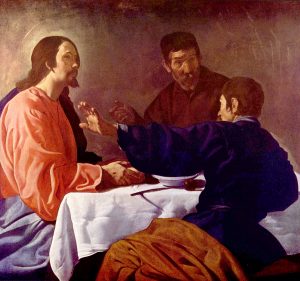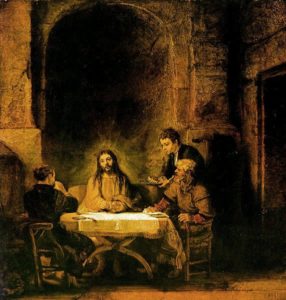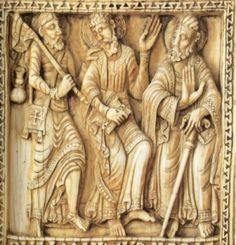Illuminations on the Lectionary readings for April 23, 2023 (Easter 3A)
First Reading: Acts 2:14a,36-41
“O God, whose blessed Son made himself known to his disciples in the breaking of bread: Open the eyes of our faith, that we may behold him in all his redeeming work.” These words in Sunday’s Collect highlight ideas of resurrection and redemption that carry through our Lectionary readings for the day.

Christ on the Road to Emmaus (c.1725-1730), American 18th Century oil painting on canvas by an anonymous artist. National Gallery of Art, Washington, D.C. (Click image to enlarge)
Let’s approach the first reading from Acts with careful attention, though. Peter’s words as told by Luke stem from a time of tension between post-Temple Judaism and early Christians who were hurt and angry over being expelled from the synagogues for their belief in Jesus as Messiah. But hearing Peter blame “the entire house of Israel” for Jesus’ crucifixion could lead Christians down the hate-filled path of anti-Judaism. It’s better to hear this reading as God’s gracious promise that the gift of the Holy Spirit is open to everyone.
Psalm: Psalm 116:1-3, 10-17
Sunday’s Psalm is heard as a hymn of gratitude for recovery. It vividly describes the anguish of illness and the fear of death. But then through prayer the Psalmist’s thoughts quickly turn from grief and sorrow to exultation and thanksgiving, reflecting the transforming joy that recovery brings. Listen closely and you’ll hear an undercurrent of resurrection as the Psalm tells us of escaping the cords of death and the grip of the grave to win the joy of new life.
Second Reading: 1 Peter 1:17-23
Our second readings in Eastertide feature passages from this letter written in Peter’s name. This week’s excerpt gives us some insight into the efforts of the early church to discern the meaning of Jesus’ death and resurrection in our lives, working in these verses on its significance as ransom for our sins. This theological quest has continued from the early church through the Middle Ages and even to our times. One point remains clear throughout: Through Christ we trust in God; through Christ we love one another, and through Christ we gain life in the enduring word of God.
Gospel: Luke 24:13-35
The two disciples on the road to Emmaus who we meet in Luke’s narrative this week seem uncertain and worried, much like the apostles fearfully hiding in a locked room who we heard about in John’s Gospel last Sunday. “We had hoped that he was the one to redeem Israel,” the two regretfully told the stranger on the road to Emmaus. They don’t seem to have been convinced by the women’s report about Jesus’s rising, either. But then they stopped to eat, and the mysterious traveler revealed himself as Jesus when he broke the bread. We remember this every Sunday in the Eucharist when the celebrant holds up and breaks the bread with an audible snap as we conclude the Eucharistic Prayer.



